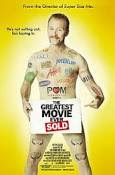Cowley and Barron in their article "When Product Placement Goes Wrong" defines product placement as "a combination of advertising and publicity designed to influence the audience by unobtrusively inserting branded products in entertainment programs such that the viewer is unlikely to be aware of the persuasive intent". The goal is to induce positive associations toward the brand that has been conspicuously placed. For instance, in three movies that I love (images below) all strategically placed the logo for Starbucks. I remember the scenes well. However, until studying product placement and writing this blog I did not remember them particularly drinking Starbucks coffee.
That is how this strategy works. It is not meant for us to know we are being persuaded to drink Starbucks coffee. The more we are exposed to a product through its placement in television shows, movies, sports etc. that we are interested in, the more our explicit memory for the brand increases. The hidden motive of persuasion is the advantage that product placements have over traditional television advertising. Although I already enjoy Starbucks products, I am sure it is solidified by how much I am exposed to its product placement in the things I enjoy watching. Product placement becomes a problem with ulterior motives are perceived and viewers realize that a brand is placed in the program to influence their brand attitude. For instance, if a woman is entrenched emotionally in a Hallmark Hall of Fame movie and then realizes a brand keeps popping up and takes her attention away from the meaning of the movie, she is probably going to develop a negative attitude toward that brand. It depends on whether the viewer is "higher in program liking (HPL)" or "lower program liking (LPL)". The HPLs depend on a program to satisfy their entertainment goals. I would imagine Nascar, Super Bowl, soap operas, talk shows, etc. are examples that would be included in this category. One of the advantages of the Starbucks placements above is they correlated with what was going on in the movie and did not avert my attention. However, when a brand is dissimilar to where it is placed, it can become annoying and obvious which brings with it negative connotations.
Another marketing strategy that can be controversial is word-of-mouth marketing. The positive aspect is when it is used openly (involving transparency) and generates "buzz" without risk of loss. This happens in audiences where people are planted to clap and laugh at certain times. WOM becomes controversial when a shill (someone planted) pretends to be neutral when, in reality, they are secretly working for the person or organization. This happens quite often in politics. Jonathan Ressler, a prominent stealth tactician, says, "if you do it right, people never know they have heard a marketing pitch. It's just a matter of presenting stuff in a different channel and trusting consumers to be smart enough to make their own choices". This makes me want to be on my Ps and Qs and not be taken advantage of or made to look foolish. I would rather make well-informed decisions than be fooled. How about you?
Transparency works on both ends of the spectrum. Balanced transparency creates a positive rapport between company and client. Transparency and risk also provide opportunity for people. Spurlock says, "if you take chances and take risks, in those risks will come opportunity. When you push people away from that you push them towards failure". The seventeen brand partners that joined him for the journey are thankful he invited them to take the risk. This also applies to us as leaders and how we challenge our employees. We need to train our employees to embrace risk that includes a logical component so that we prepare our entire company to be greatly rewarded.

If asked what your personal brand would look like, what would you say? I would have to say mine would be an ELF CCC (enjoy life fully while crazy, casual, classy).






No comments:
Post a Comment